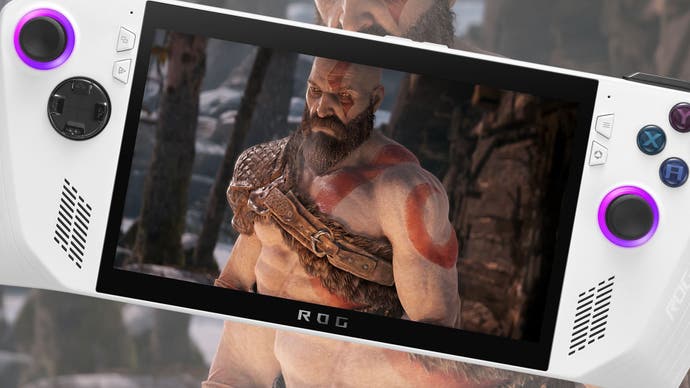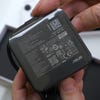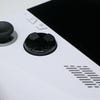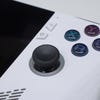Asus ROG Ally vs Steam Deck: can powerful new tech deliver a game-changing handheld?
Out-specs Steam Deck - but battery life and bugs are problematic.
It's here - and as manufacturer Asus promised - sooner than expected. The Asus ROG Ally arrives just over a year since Steam Deck added a new dimension to PC gaming: portability. Not longer the domain of the bedroom or office, it's now possible to play your library of games anywhere and not just your legacy titles either, but the latest triple-A epics... to a certain degree. The Steam Deck struggles with the latest, most demanding games but the Asus ROG Ally doesn't just offer up the hardware spec improvements we've love to see added to Deck - but adds anything up to 71 percent in gaming performance. So what's the catch?
At the heart of the Ally sits the latest AMD mobile APU - dubbed the Z1 Extreme. This seems to be a tweaked rendition of its flagship 'Phoenix' silicon, specifically the Ryzen 7 7840U. CPU core count doubles up against Steam Deck and frequencies increase dramatically, while employing the latest Zen4 designs. Meanwhile the GPU has 50 percent more compute units, an architecture upgrade via RDNA 3 and - once again - a lot more frequency. 16GB of LPDDR5 across a 128-bit memory interface completes the core spec. At this point, it's not entirely clear how the Z1 Extreme differs from the 7840U as those spec points are very similar, right down to the new 4nm processor node - another advantage vs the Deck's 7nm design.
In the spec table below, you'll note that I've also included the specs from a similarly new handheld - the AyaNeo Air Plus. I've added this to the mix as it's based on the 6nm Ryzen 7 6800U, AMD's last generation flagship: think of it as an iterative step on from the Deck's custom AMD Van Gogh APU. It's built from the same fundamental building blocks as the Deck but benefits from a much bigger CPU and GPU. We'll see how AMD's new flagship compares to the old later on in the review, but you'll note that the basic set-up is quite similar to the Z1 Extreme.
| Asus ROG Ally | AyaNeo Air Plus | Steam Deck | |
|---|---|---|---|
| Main Processor | AMD Z1 Extreme | AMD Ryzen 7 6800U | Custom AMD 'Van Gogh' |
| CPU | Zen4, Eight Cores, 16 Threads, Max 5.0GHz | Zen3+, Eight Cores, 16 Threads, Max 4.7GHz | Zen2, Four Cores, Eight Threads, Max 3.6GHz |
| GPU | RDNA 3, 12 Compute Units, Max 2.6GHz | RDNA 2, 12 Compute Units, Max 2.2GHz | RDNA 2, 8 Compute Units, Max 1.6GHz |
| Peak GPU Compute | 8.60TF | 3.38TF | 1.64TF |
| Memory | 16GB LPDDR5 6400MT/s | 16GB LPDDR5 6400MT/s | 16GB LPDDR5 5500MT/s |
| Display | 1920x1080 - 120Hz IPS with VRR | 1920x1080 - 60Hz IPS | 1200x800 - 60Hz IPS |
| Battery | 40WHr | 46.2WHr | 40WHr |
| Default OS | Windows 11 | Windows 11 | SteamOS |
| I/O | One USB-C, MicroSD, Headphone Jack, PCIe Extender Port | Three USB-C, MicroSD, Headphone Jack | One USB-C, MicroSD, Headphone Jack |
Opening up the box, there's not much to the Ally's packaging. The handheld itself is immediately below the lid with no protection (which is a touch worrying) while directly under that sits paperwork, a 65W power supply and a power cable. Asus also supplied a separate charger that also acts as a USB hub and features an HDMI 2.0 output, but that'll be a separate purchase for users - it's a bit odd to have the video and USB outputs on a plug, but there it is. I'd recommend a more conventional USB-C hub instead.
The handheld design itself is remarkably good. The Ally is easy to hold with textured grips, Xbox-like facebuttons, stick and d-pad along with clicky shoulder buttons and familiar triggers. On the rear sits a couple of 'paddle'-style buttons, while RGB accents are also in effect around the sticks.
IO consists of power and volume buttons, a single USB-C, micro-SD slot and 3.5mm stereo jack for headsets. There's also a PCIe interface for connecting Asus's line of mobile GPUs up to the RTX 4090, at which point the Ally's iGPU is switched out in favour of the external processor. This frees up the CPU to make full use of memory bandwidth and power budget, no longer needing to compete with resources to the onboard Radeon 780M. The IO does the job, but I would have welcomed an extra USB-C or two (the AyaNeo 2 has three!).
There are two further elements of the hardware design I'd like to flag for praise. First of all, the screen is excellent - bright, with excellent colour reproduction. It's a 1080p panel that operates at 120Hz and supports FreeSync. It looks like the adaptive sync range is from 48Hz to 120Hz, with VRR disabled entirely if you switch the panel to 60Hz... so don't do that. Although targeting 40fps takes you outside of the VRR window, switching to normal v-sync will still work for smooth gaming as 40fps divides perfectly into the 120Hz output.
Another point of interest is that screen-tearing with v-sync off does present in the usual horizontal way. Portables like Steam Deck and the AyaNeo devices (and almost certainly Nintendo Switch) actually use repurposed mobile portrait displays, so screen-tearing moves left-to-right in a way that looks even worse than usual - which may explain why Steam Deck and Switch operate all games with v-sync enabled.
The second exemplary point to highlight is the cooling arrangement. You’ll hear a lot about the Ally's cooler design - twin fans, zero gravity thermal system, fluid dynamic bearings, 0.1mm ultra-thing fins, but the reality is that this is the quietest PC gaming handheld I've ever tested. It's more Switch than Steam Deck on both 15W performance and 25W turbo modes. The fans only really kick in hard on the 30W mains turbo mode but even then, it's still relatively quiet overall.
From a general hardware design, the Ally does almost everything the enthusiast would have wanted from Steam Deck - the loud cooler and sub-par screen are comprehensively addressed with excellent solutions. However, it is still a Windows handheld - and SteamOS on the Deck has demonstrated that a bespoke front-end can be game-changing. On top of that, Windows has yet to acquit itself with a properly efficient design. Battery life can be challenging on Deck - but it's a whole lot more difficult on a Windows machine and the Asus ROG Ally doesn't quite crack that, as we shall discover on the next page.
Asus ROG Ally vs Steam Deck Review
- Introduction, hardware, specs [This Page]
- Software, power modes, battery life
- Game benchmarks: Control, Forza Horizon 5, God of War
- Game benchmarks: Cyberpunk 2077, A Plague Tale: Requiem, Returnal, Metro Exodus Enhanced Edition
- Great specs and performance, poor battery life and bugs: the Digital Foundry verdict


















